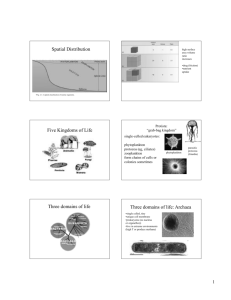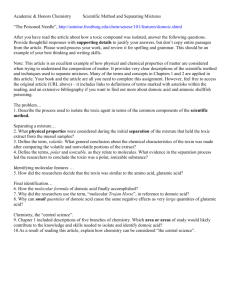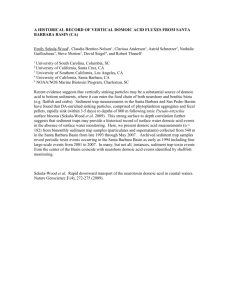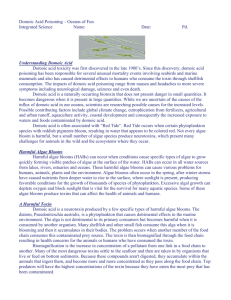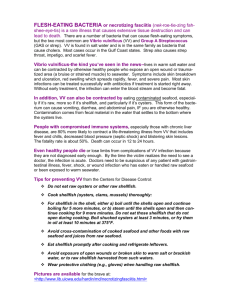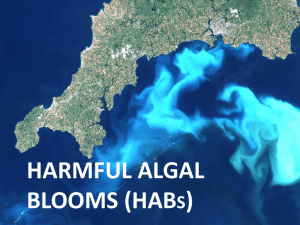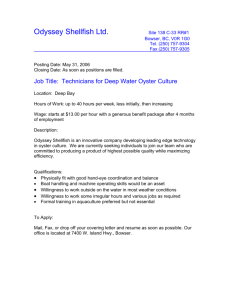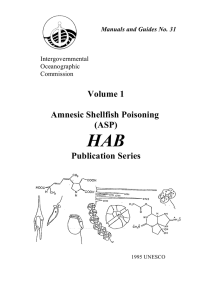Domoic Acid Toxicity
advertisement
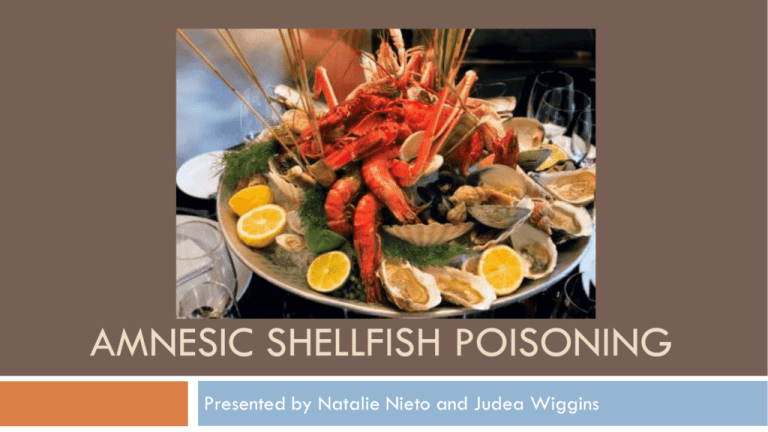
AMNESIC SHELLFISH POISONING Presented by Natalie Nieto and Judea Wiggins Amnesic Shellfish Poisoning– What interested us? Throughout the course of Biology of Toxins, we have learned that there is “no free lunch.” Many substances we view as harmless can often pose a serious threat. As amnesic shellfish poisoning results from the consumption of seafood containing dangerous levels of domoic acid, we felt this to be an interesting topic to pursue. Seafood is consumed widely across the globe, therefore becoming more aware of its toxic possibilities is essential. Amnesic Shellfish Poisoning – How Will We Present It? In this presentation, we will discuss amnesic shellfish poisoning (ASP) in all its entirety, including: General overview of what constitutes a substance as ‘toxic’ Introduction and background information of amnesic shellfish poisoning A detailed overview of domoic acid The role the environment plays in ASP, specifically algal blooms Toxic effects and symptoms Treatment options Prevention Regulation Statistics Most recent outbreak Research findings Suggestions for further study Toxin – What is it? A toxin is a substance produced by an organism that has an adverse effect on another organism. The “no free lunch” principle indicates every substance to hold the potential of being toxic under the right conditions, specifically the dose of the substance and the organism exposed to the substance. A toxic substance may function as a defensive mechanism, an offensive mechanism, or both. For marine toxics, a naturally-occurring chemical is produced by a marine organism that becomes toxic to humans upon consumption of contaminated seafood. Amnesic Shellfish Poisoning – What is it? Amnesic shellfish poisoning (ASP) is an illness caused by the ingestion of contaminated shellfish, i.e. mussels, clams, oysters, and even Dungeness crabs that prey on shellfish. Shellfish become ‘contaminated’ when they consume phyloplankton, or algae, containing high concentrations of the marine toxin, domoic acid. Domoic Acid – When was it discovered? The first diagnosed case of Amnesic Shellfish Poisoning occurred in 1987 after 3 deaths and 100+ acute intoxications took place in Canada, following consumption of blue mussels. However, it wasn’t until 1998 that domoic acid toxicosis was first diagnosed in marine mammals by the Marine Mammals Center. Domoic Acid – What is it? Domoic acid is an excitatory neurotransmitter and derivative of glutamine; it is also a conditionally essential amino acid –not synthesized by the body, but instead dietary-obtained. Domoic acid is produced by diatoms of the genus, Pseudo-nitzschia. Diatoms are the most common type of phytoplankton: single-celled, photosynthetic algae. These diatoms can be found in coastal waters all around the world, and serve as a major nutrient source for many plankton consumers, such as whales, shrimp, fish, and jellyfish. Pseudo nitzschia – Why do they produce domoic acid? Research has shown that the presence of iron, or lack there of, plays a role in governing phytoplankton growth; lower amounts of available iron are associated with lower growth rates. More than 99% of dissolved iron in the ocean is bound to other complex elements such as saccharides; phytoplankton have devised methods to access this bound iron. Scientist speculate that this particular genus produces domoic acid as a function of the iron uptake mechanism by increasing affinity. This, in turn, gives P. nitzschia a competitive edge against other phytoplankton for proliferation in times where iron is less abundant. Domoic Acid – What is its mechanism? 1. 2. Domoic acid acts as a glutamate agonist, upregulating glutamate production. When glutamate is expelled from the pre-synaptic cell’s vesicle, it then binds to the glutamate receptor, NMDA, which triggers calcium channels to open. Domoic Acid – What is its mechanism? 3. 4. With glutamate receptors being overwhelmed by glutamate ligands, calcium channels do not close on the postsynaptic cell. Influx of calcium on the postsynaptic cell leads to constant excitatory action potentials being produced. Calcium Overload – Why is it dangerous? Excessive stimulation of neurons by excitatory action potentials leads to excitotoxicity; under these conditions, cells are either damaged or undergo apoptosis. Constant calcium influx into cells inadvertently activates degradative enzymes such as phospholipases, endonucleases, and proteases that destroy the lipid bilayer, DNA, and other components of the extracellular matrix in the central nervous system. Domoic Acid – What is its pathology? In acute exposure, brain damage occurs in the form of neurodegenerative changes such as neuronal shrinkage, edema, cytoplasmic swelling, and numerous other neurological symptoms. The hippocampus, memory center, is a specific target site for domoic acid; this is why loss of short term memory is a notable symptom. The inner nuclear layer of the retina of the eye may also undergo damage, along with spinal chord lesions, leading to motor sensory abnormalities due to damage of the gray matter. Direct cardiotoxicity is also observed, but is unlinked to the effects of domoic acid on cardiovascular control centers in the central nervous system. Algal Blooms – What role do they play? While diatoms are a normal component of all aquatic environments, when they reproduce in significant numbers, they result in algal blooms. This overproduction of algae leads to an abundance of dead organic matter, and thus a subsequent increase in the production of bacteria. Bacteria consume dissolved oxygen in the water, making it difficult for aquatic life to survive. Algal blooms become harmful by the overabundant production of phosphorus and nitrogen within the surrounding water source, leading to the hyper-production of domoic acid-containing algae. As aquatic animals like shellfish feed upon this toxic algae, our seafood sources become contaminated. Algal Blooms – What is different between fish and humans? Many aquatic organisms, especially shellfish, filter feed on this toxic algae. In overconsumption, domoic acid builds up in their tissues, but causes no apparent physiological harm. Problems occur, however, when humans unknowingly consume contaminated shellfish, thus leading to the onset of amnesic shellfish poisoning. Algal Blooms – How can we identify them? Algal blooms may occur in both freshwater and marine environments. The photosynthetic pigment of the infected algal cells determines the color affected water sources depict. For instance, cyanobacteria algal blooms are known as blue-green algae based on the bluegreen tint observed in affected water areas. With phytoplankton, a red or brown tint is observed, which is why the affected water area is often referred to as a “red tide.” Amnesic Shellfish Poisoning – What are the symptoms? Within 24 hours of consumption of contaminated seafood, an onset of the following symptoms results: Vomiting Diarrhea Nausea Abdominal cramps Within 48 hours, more severe poisoning cases will result in serious neurological symptoms of: Headaches Dizziness Confusion and disorientation Permanent loss of short-term memory Motor weakness Cardiac arrhythmias Coma Death Allergy to Shellfish – Is ASP the same thing? When someone is allergic to shellfish, their body produces an immune response to the consumption of shellfish. While this immune response can range from mild to severe, it is not brought on by actual toxicity. Instead, the body is responding to the shellfish protein of allergen by triggering the production of antibodies and the release of histamine. Amnesic Shellfish Poisoning – How is it treated? Unfortunately, no highly effective antidote exists to combat the effects of domoic acid toxicity that result in amnesic shellfish poisoning. Positive effects have been observed, however, in reducing seizures with diazepam, a muscle relaxer, administered in conjunction with phenobarbital, an epilepsy deterrent, intravenously. In the event of respiratory failure, the best means of treatment is to administer life support until the toxin has been expelled from the victim’s body. Safe Seafood Consumption – How can I prevent ASP? The best means of protection is practicing prevention. It is important to note that domoic acid is not neutralized by cooking the contaminated shellfish. Commercial and local shellfish harvesting companies are strictly monitored by federal and state health departments. Levels of domoic acid are routinely tested to ensure safe seafood consumption. In the event that levels of domoic acid are detected over 20 micrograms per gram of wet weight, harvesting must be halted in that area until levels decrease over time. Safe Seafood Consumption – How can I prevent ASP? According to the CDC, there are a few general guidelines one should adhere to when consuming seafood: Consuming raw seafood or shellfish holds great potential to cause illness due to the various bacteria found in seawater and should be avoided by persons with weakened immune systems Seafood should be kept on ice or refrigerated at temperatures below 38°F Safe Seafood Consumption – How can I prevent ASP? The CDC also recommends more specific guidelines to safe consumption of seafood: Refrigeration of fresh tuna, mackerel, grouper, and mahi mahi is essential to prevent poisoning Barracuda, especially those obtained from the Caribbean, should always be avoided Remaining up-to-date with local and national health official advisories regarding algal blooms, bacterial growth, and “red tide” conditions is pertinent Avoid finfish or shellfish that are used as bait as they are not held under the same safety food regulations Regulation – What is the Government doing? The U.S. Food and Drug Administration is responsible for regulating seafood guidelines. The Federal Food, Drug and Cosmetic Act, the Public Health Act, and similar regulations aim to prevent the occurrence of marine toxic poisoning through the publication of the Fish and Fisheries Products Hazards and Controls Guidance manual. This serves to provide up-to-date science and policies regarding potential hazards of seafood. Regulation – What is the Government doing? The guidelines presented by the FDA serve as reference to fish and fishery product regulatory programs globally with regulations addressing: Procedures for the safe and sanitary processing and importing of fish and fishery products Specific Enhanced guidelines for the processing and importing of crabmeat aquaculture and seafood inspection Guidance – What is the Government doing? In addition to providing strict regulations, the FDA provides extensive guidance by which fish industries may follow to prevent seafood poisoning, including: Guidance for purchasing reef fish species Guidance for interstate commerce Processes for inspection and certification of seafood export Guidance for implementing a HACCP (Hazard Analysis and Critical Control Points) prevention system Statistics – How often does this occur? According to the CDC, approximately 30 cases of marine toxin poisoning occur in the United States yearly. Unfortunately, there are no requirements to reporting cases of marine toxin poisoning. Some cases are mild and therefore go undiagnosed. As a result, it is likely the number of poisonings is much greater than we estimate, and in turn, makes it difficult to specifically estimate ASP cases. Statistics – How often does it occur? Based on the data available, however, it is estimated that one person dies every 4 years from marine toxin poisoning. Interestingly enough, poisoning is more common during the summer months due to better growing conditions of phytoplankton and development of algal blooms. Domoic Acid Toxicity in the News – When was the last outbreak? In 2014, a population of shellfish, specifically mussels, were identified to contain dangerous levels of domoic acid. As a result, the California Department of Public Health advised consumers to avoid recreationally harvested shellfish from Monterey and/or Santa Cruz. As certified, commercial harvesters and dealers of shellfish are under strict regulations and mandated to frequent screening for toxins, shellfish obtained from these sources were approved during the outbreak. Research – What did they find? In a recent study, researchers focused on a “new” area that domoic acid from amnesic shellfish poisoning may affect, the kidneys. As the kidneys are responsible for expelling the toxin via renal filtration, they also express ionotropic glutamate receptors. With increased production of glutamate by its agonist, domoic acid, researchers conducted an experiment on mice to determine the renal effects of domoic acid. Research – What did they find? Upon administering neurotoxic dose(s) to experimental mice, researchers discovered an accumulation of domoic acid in the kidneys, comparable to renal vascular and tubal damage associated with acute tubular necrosis, apoptosis, and renal tubular cell desquamation. These effects result in toxic vacuolization and mitochondrial swelling, characterizing cellular damage. Fig.1. Cellular damage, including endothelial cell and mitochondrial swelling and vacuolization. Summary – What have we learned? We have presented a detailed explanation of amnesic shellfish poisoning, including its definition, symptoms, treatment, and prevention. Addressing the key component making shellfish toxic, we have provided detailed and pertinent information regarding domoic acid, most specifically the mechanism by which the human body is harmed. With this presentation, we have provided adequate and valuable information to consider when consuming shellfish. Conclusion – Where do we go from here? Based on the research findings of the effects on the kidneys, regulatory policies could be modified to account for the additional harm caused, specifically in determining “safe” doses of domoic acid. With little information known regarding domoic acid’s effect on shellfish, it would be interesting to explore why domoic acid does not produce the same harmful effects it does on humans. Lastly, as the “no free lunch” principle also applies, it would be intriguing to speculate why only this specific algae species produces the toxin, i.e. what is the cost and benefit of doing so. References http://www.cdc.gov/ncidod/dbmd/diseaseinfo/marinetoxins_g.htm http://www.foodsafetynews.com/2014/04/officials-say-recreationally-harvested-shellfish-from-two-ca-counties-containtoxin/#.VTnu0fnF8uc http://www.marinemammalcenter.org/science/top-research-projects/domoic-acid-toxicity.html http://www.mbari.org/staff/conn/botany/diatoms/jennifer/toxin.htm http://www.ncbi.nlm.nih.gov/pmc/articles/PMC2525487/ http://www.nmfs.noaa.gov/pr/pdfs/health/domoic_acid.pdf http://www.nwfsc.noaa.gov/hab/habs_toxins/phytoplankton/ http://www.sciencedaily.com/articles/e/excitotoxicity.htm http://westerndiatoms.colorado.edu/about/what_are_diatoms http://www.whoi.edu/science/B/redtide/illness/asp.html http://en.wikipedia.org/wiki/Excitotoxicity http://www2.epa.gov/nutrientpollution/harmful-algal-blooms Funk, J.A., Janech, M.G., Dillon, J.C., Bissler, J.J., Siroky, B.J., and Bell, P.D. (2014). Characterization of renal toxicity in mice administered marine biotoxin domoic acid. Journal of the American Society of Nephrology, 25. http://www.newswise.com/images/ee/pdf/613059.pdf Prince, E.K., Irmer, F., and Pohnert, G. (2013). Domoic acid improves the competitive ability of Pseudo-nitzschia delicatissima against the diatom Skeletonema marinoi, 11(7). http://www.ncbi.nlm.nih.gov/pmc/articles/PMC3736430/
